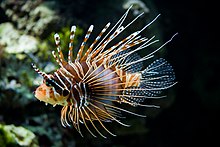|
Spine (zoology)In a zoological context, spines are hard, needle-like anatomical structures found in both vertebrate and invertebrate species. The spines of most spiny mammals are modified hairs, with a spongy center covered in a thick, hard layer of keratin and a sharp, sometimes barbed tip. OccurrenceMammals Spines in mammals include the prickles of hedgehogs, and among rodents, the quills of porcupines (of both the New World and the Old), as well as the prickly fur of spiny mice, spiny pocket mice, and of species of spiny rat. They are also found on afrotherian tenrecs of the family Tenrecinae (hedgehog and streaked tenrecs), marsupial spiny bandicoots, and on echidnas (a monotreme). An ancient synapsid, Dimetrodon, had extremely long spines on its backbone that were joined together with a web of skin that formed a sail-like structure. Many mammalian species, like cats and fossas,[1][2] also have penile spines. The Mesozoic eutriconodont mammal Spinolestes already displayed spines similar to those of modern spiny mice.[3] Fish    Spines are found in the fins of most bony fishes, particularly actinopterygians (ray-finned fishes), who have folding fan-like fin made of spreading bony spines called lepidotrichia or "rays" covered by thin stretches of skin. In the other bony fish clade, the sarcopterygians (lobe-finned fish), the fin spines (if any at all) are significantly shorter and each fin is instead dominated by a muscular stalk ("lobe") with a jointed internal appendicular skeleton. The limbs of tetrapods, who descended from sarcopterygian ancestors, are homologous to the paired pectoral and pelvic fins. Some fish, such as scorpion fish and lionfish, has prominent sharp, venomous spines for anti-predator defense. The tail stinger on a stingray is also a type of barbed spine modified from dermal denticles. The acanthodians, an extinct class of ancient fish that are paraphyletic to the cartilaginous fishes, have prominent bony spines in the front (rostral) edges of all fins except the tail. The primary function of these rigid spines are generally presumed to be defensive against predators, but other proposed roles are as cutwaters to reduce drag or as holdfasts against subsurface currents.[4] Invertebrates Defensive spines are also found in invertebrate animals, such as sea urchins. They are a feature of the shell of several different species of gastropod and bivalve mollusks, including the venus clam Pitar lupanaria. Many species of arthropods also have spine-like protrusions on their bodies for defensive purposes. For example, the rostra on many shrimp species form a sharp spine that can be used against predators. The urticating bristles or setae on many caterpillars and New World tarantulas are essentially tiny detachable spines that can cause severe irritation upon contact. Those on the Lonomia caterpillars are venomous and can cause lethal coagulopathy, hemolysis and kidney failure. Spines are also found in internal organs in invertebrates, such as the copulatory spines in the male or female organs of certain flatworms. FunctionIn many cases, spines are a defense mechanism that help protect the animal against potential predators. Because spines are sharp, they can puncture skin and inflict pain and damage which may cause the predator to avoid that species from that point on. The spine of some animals are capable of injecting venom. In the case of some large species of stingray, a puncture with the barbed spine and the accompanying venom has occasionally been fatal to humans. Animals such as porcupines are considered aposematic, because their spines warn predators that they are dangerous, and in some cases, potentially toxic.[5] Porcupines rattle their quills as a warning to predators, much like rattlesnakes use their rattles.[5] Treating injuries caused by spinesBecause many species of fish and invertebrates carry venom within their spines, a rule of thumb is to treat every injury as if it were a snake bite. Venom can cause intense pain, and can sometimes result in death if left untreated.[6] On the other hand, being pricked by a porcupine quill is not dangerous, and the quills are not poisonous. The quill can be removed by gently but firmly pulling it out of the skin. The barbed tip sometimes breaks off, but it works its way out through the skin over time.[7] Human usesCommon uses for animal spines include:
References
|